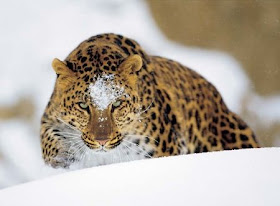The Life of Animals | Amur leopard | Amur leopards differ from other subspecies by a thick coat. Leopards from the Amur river basin, the mountains of north-eastern China and the Korean peninsula have pale cream-colored coats, particularly in winter. The winter coat varies from light yellow to fairly dense Yellowish-red with a golden tinge or rusty-reddish-yellow. The summer pelage is brighter with more vivid coloration pattern. Males range in weight from 32.2-48 kg (71-110 lb), and Females from 25-42.5 kg (55-94 lb). Amur leopards used to be found in Northeastern China, probably in the south to Peking, and the Korean Peninsula.
There it turned steeply Westward, north of the basin Suchan, then north to Encompass the source of Ussuri River and two right bank tributaries in the Upper Reaches of the Ussuri. There the boundary turned Westward toward the bank of Lake Khanka. In the 1950s, leopards were observed 50 km (31 mi) north of Vladivostok and in Kedrovaya Pad Nature Reserve. The association of Amur leopards with mountains is fairly definite. They are confined more to places where wild sika deer live or where deer husbandry is Practised. In winter snowfree They keep rocky slopes to the south facing In the 1970s, the Russian population had fragmented into three separate, small Populations.
The only North Korean official government site, Naenara, reported in 2009 That in Myohyangsan Nature Reserve located in Hyangsan County, there were some leopards. It is Likely the Southernmost living group of Amur's Leopard. The young open Their Eyes on the 7th-9th day and begin to crawl on the 12th-15th day. In Kedrovaya Pad Nature Reserve Situations are known, in the which the young of two different litters stayed with the mother at the same time
A captive population of Amur leopards was established in 1961 from nine wild-born founders. A molecular genetic survey at least two Revealed That founders of the captive pedigree have more genetic information consistent with Panthera pardus japonensis wildborn than any specimens of P. p. orientalis. This observation lends support to a history of Amur leopards Between Genetic Admixture and North Chinese leopards in the captive pedigree. The zoo population in both the American and European regions includes a considerable contribution of genes from Founder 2, the WHO was not an Amur leopard. As of December 2011, there are 176 captive Amur leopards in zoos worldwide. Within the EEP 54 male, 40 female and 7 unsexed individuals are kept. In North American and Canadian zoos another 31 males and 41 Females are kept within the Population Management Program.
The Animal Planet documentary, The Last Leopard (2008) is about the Plight of Amur leopards in Russia. The television series "Wild Russia" showed a quick glimpse into the life of the Amur leopard. A female Amur leopard and her cub were featured on Planet Earth episodes "From Pole to Pole" and "Seasonal Forests". The male cub Died at the age of around 18 months; he was the result of inbreeding - the cub's sire's sire was also Skrytnaya





